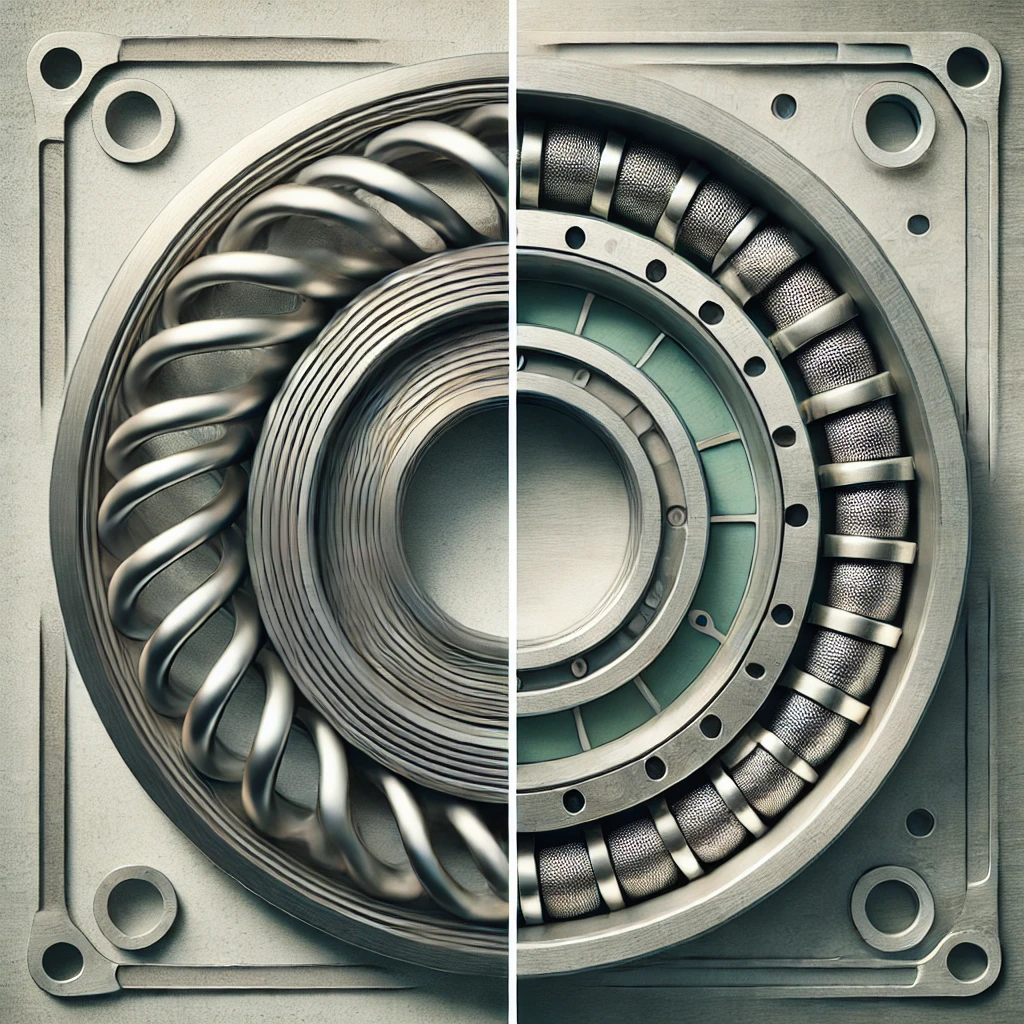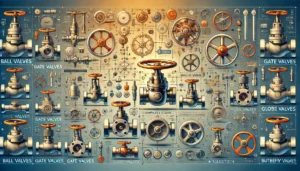If gaskets are to be classified in terms of frequent use, it is likely that most people will put Spiral wound gaskets at the top, closely followed by Kammprofile gaskets. Both the spiral wound and Kammprofile gaskets have an important responsibility of providing a leak proof seal for piping connections, heat exchangers and pressure vessels. However, their construction details, sealing mechanism, performance and pricing are very different. Knowing these differences is important so that in industrial setting the right gasket is put into use in accordance to its requirements.
Let’s look at the construction of these two types of gaskets.
The most fundamental difference lies in the construction of these two gaskets. The cross section of a spiral wound gasket consists of several alternating layers of soft material (graphite or PTFE) filler and metal wound into spiral shapes. Such a cross-sectional structure enables the gasket to expand and flex when compressive forces are applied throughout the joint allowing volumetric strain caused by thermal expansion or contraction of the joint. On the other hand, Kammprofile gaskets have a solid metallic center with grooves cut on both longitudinal sides of the metal core which are filled with gasket material such as PTFE or graphite; this material serves as the main sealing surface upon compression.
In comparison, Kammprofile gaskets provide a much stronger and better built devise as their solid metal core with grooves cuts fqacilitates this rather than having a spiral wound gasket with a layered structure spiral wound gasket. Because of their uniform consistency, Kammprofile gaskets are more effective for applications that require a high degree of sealing integrity.
Sealing Mechanism
Another important difference consists of the sealing mechanism of both gaskets. With the spiral wound gaskets, the seal is created by compressing the metal as well as the filler layers. Filling materials deform, when bolted, to seal the gaps on the flanges and the metal layers act as structural components. On the other hand, the Kammprofile gaskets depend on grooves to seal the gaskets by compressing the sealing material. The presence of grooves on the metal core expands the area covered by sealing material thus increasing the amount of sealant in contact with the surface for better sealing under elevated pressures.
The variation in sealing mechanisms determines the applications for which they are best suited. Due to their flexibility, spiral wound gaskets are best suited in applications where there are low and moderate pressure and temperature variations. Kammprofile gaskets are best suited in applications with high-pressure and high-temperature resistance owing to their solid core.
Performance and Durability
Both Kammprofile gaskets and single gaskets perform effectively in high temperatures and pressure conditions but the former performs better in extreme conditions. Their solid metal core ensures better blowout resistance and seals more effectively. Spiral wound gaskets are effective in many applications, however, they are prone to damage during their handling, installation, or disassembly. This makes them normally one-time use.
Kammprofile gaskets, on the other hand, are quite easy to reuse. When you unbolt the gasket and the metal core does not take any damage, the sealing material is preserved and can be subsequently resealed increasing the life of the gasket. This means that, in the longer perspective, kammprofile gaskets are more cost efficient than other types of gaskets when used for critical applications.
Installation and Operation
Kamm gaskets as stated earlier are easier to use and install compared to spiral wound gaskets owing to their rigid structure. Spiral wound gaskets require exact bolt loadings while twisting otherwise the sealing material inside will be damaged. Failure to apply even loads on the all bolts may also result in failure to achieve the required quantity of compression on the seal. In comparison, Kamm gaskets are quite durable and less sensitive to uneven bolt loadings thereby making themselves ideal for applications where accurate installation might be difficult.
Cost Factors
Cost is yet another determining factor when making the compromise between these two gaskets. Due to their simpler design, spiral gaskets are relatively cheap. Nonetheless, the spiral gaskets lower cost is outweighed its drawbacks i.e. single time use and sensitivity to the elements leading to the gaskets having to be replaced over the desired period. Kamm gaskets are more expensive when compared on a one-off basis, however, when taking into account their re usability and durability especially when used in high pressure critical applications, Kamm gaskets are more than worth the investment.
Applications
Spiral wound gaskets are widely employed in piping systems, heat exchangers, and pressure vessels operating under moderate conditions of pressure, temperature changes, and thermal cycles. Their ease of use makes them suitable in a variety of industrial situations. In the oil and gas, chemical and power generation industries, Kammprofile gaskets are used on critical flanges and heat exchangers because of their ability to seal and resist seal blowouts even under very high pressures and temperatures.
Conclusion
Kammprofile and Spiral wound gaskets are effective for different applications due to their particular benefits and drawbacks. Spiral wound gaskets are preferred for ordinary industrial uses due to their adaptability and cost effectiveness. Those made of Kammprofile materials are preferred in places where extreme conditions of pressure and temperature exist due to their strength, sealing efficiency and ability to be reused. The right sealing application can be achieved through appreciating their differences for performance and safety.










